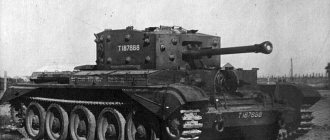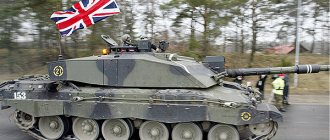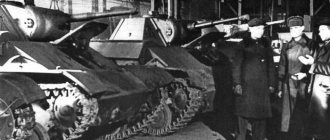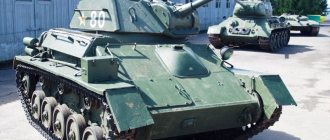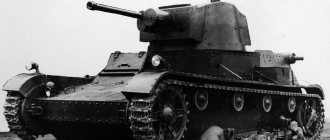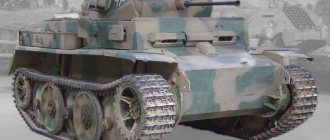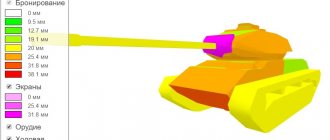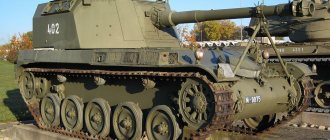Light cruiser tank Mk VII Tetrarch (UK)
In the second half of the thirties of the last century, the British military came to the conclusion that it was necessary to urgently modernize the fleet of armored vehicles, in particular light vehicles.
Soon the industry presented new models of military equipment, which managed to interest potential customers. One of the most interesting and promising projects was the A17 light tank, later designated Mk VII Tetrarch. In addition to successfully solving the initially assigned tasks, this vehicle was later able to become the basis for a whole family of armored vehicles for various purposes. The development of the future Mk VII light tank had been carried out by Vickers-Armstrong since the end of 1935. On its own initiative, the company decided to develop a new version of promising armored vehicles, which compares favorably with existing models of a similar class. Leslie Little was appointed chief designer of the new project. The company's management set several main tasks for the engineers. First of all, it was necessary to create a light tracked vehicle that would be superior to the existing models. In addition, the new project should have abandoned the ideas and solutions patented by the designers J. Carden and W. Lloyd. With the help of such project features, the company's managers wanted to reduce the cost of licensing fees.
The first prototype of the A17E1 tank. Photo: Aviarmor.net
The last requirement allowed L. Little and his colleagues to abandon a number of tried and tested solutions and apply completely new original ideas to the project. However, all unusual proposals required testing in practice. To this end, in 1936 the design team developed a tracked tractor based on “tank” ideas. The car was successfully tested and even offered to potential buyers. However, farmers were not interested in such equipment, which is why the development company focused on creating a promising tank.
The preliminary design of a light tank was completed in the fall of 1936, after which the management of Vickers-Armstrong offered it to the military department. Due to the characteristic design features, the armored vehicle was supposed to have improved maneuverability. In addition, it compared favorably with existing models due to its increased firepower. The project received government support and also acquired a new designation - PR. The name A17 soon appeared. At that time, the tactical niche of the new tank had not yet been determined. This issue was planned to be resolved based on the test results.
During 1937, the contracting company completed the development of the project and built a running prototype of the promising tank. It had a full-fledged chassis with a full set of armor, but instead of a turret it carried a wooden unit of the required shape with weapon models. In this form, the mobility and maneuverability of the vehicle was checked. It was planned to test the weapon and establish the features of its interaction with the rest of the vehicle during the following checks. The first prototype received its own designation A17E1. The second machine with a full set of equipment was to be called A17E2.
Production tank Mk VII. Photo Imperial War Museum / Iwm.org.uk
It was during testing that the military and designers had to face the problem of classifying a promising armored vehicle. The calculated combat weight and bulletproof armor required the PR/A17 tank to be classified as a light tank. At the same time, the project proposed the use of a 40-mm cannon and a fairly powerful engine, which transferred it to the cruising category. As a result, this problem was resolved by expanding the existing classification of armored vehicles. It introduced a new class of tanks – light cruisers. The only representative of this class, however, for some time was the A17.
During testing of the first prototype A17E1, some shortcomings of the existing design were identified. They were taken into account in the updated version of the project, according to which the second experimental A17E2 was built. Based on the results of testing the improved prototype, it was decided to abandon further construction of prototypes. Thus, the second tank became the standard for production vehicles. This armored vehicle was put into service under the designation Light Cruiser Tank Mk VII. The corresponding order was signed in June 1938. In 1941, the new armored vehicle received its own name Tetrarch.
Initially, the goal of the A17 project was to create a light tank, superior in its main characteristics to existing equipment of this class. One of the ways to ensure the required superiority was the development of a new armored hull with an increased level of protection. It was proposed to use front and side armor with a thickness of 14 mm. The stern should have been made of 10 mm sheets, and the hull roof had a thickness of 7 mm. The maximum thickness of the turret parts was 16 mm. The sheets were assembled into a single structure using rivets. The hull was built according to a classic layout with a front control compartment, a central fighting compartment and an aft engine compartment.
View of the left side. Photo Imperial War Museum / Iwm.org.uk
The hull of the Tetrarch tank received a frontal part of a recognizable shape. It consisted of a bottom sheet located at a slight forward inclination, above which there was an inclined upper part. The latter was connected to the front wall of the turret box. In addition, it housed the driver's cabin, located in the center. The turret box had vertical sides. Behind it was the sloping roof of the engine compartment. The stern plate of the hull was rolled back. Fenders were attached to the side of the hull, on which boxes for transporting various property were also placed. At the stern there were mounts for a cylindrical fuel tank.
A turret consisting of several armor plates of different shapes was used. There was a rectangular frontal sheet with an embrasure for weapons, diverging zygomatic sheets and sides, forming a rear niche of reduced width. The height of the tower also changed: its central part was higher than other sections.
The aft compartment of the vehicle housed a Meadows MAT 12-cylinder gasoline engine with a power of 165 hp. Next to the engine was a manual transmission based on a Meadows Tour 30 five-speed gearbox. The transmission provided torque to the rear drive wheel.
Starboard and stern. Photo Imperial War Museum / Iwm.org.uk
Designers under the leadership of L. Little developed an original chassis that made it possible to improve the controllability and maneuverability of the tank. On each side there were four large-diameter rollers. The rollers were equipped with individual spring suspension. The three front pairs of rollers were equipped with rubber tires and served as support wheels. The stern pair, in turn, did not have rubber parts and were used as drive wheels. No support rollers were used. The most interesting innovation was the installation of rollers on hinges, which allowed them to rotate around a vertical axis. The rollers carried a small-link caterpillar, consisting of 99 tracks with a width of 241 mm. The design of the tracks and their hinges allowed the stretched track to bend in a horizontal plane.
The controlled oscillating rollers were connected using a rod system to the main control in the form of a car-type steering wheel. To turn, the driver could rotate the steering wheel, resulting in a change in the position of the rollers. At the same time, the caterpillar bent in the desired direction, and the tank entered the turn without braking one of the drive wheels. At the same time, however, the possibility of turning “like a tank” remained. When taxiing with rollers, the tank showed a turning radius of 28.5 m.
Demonstration of new equipment to personnel. Photo Imperial War Museum / Iwm.org.uk
The turret of the A17 tank was equipped with a 40-mm Ordnance QF 2-pounder rifled gun and a coaxial 7.92-mm BESA machine gun. Guidance of both types of weapons was carried out using common drives and using telescopic sights. The tank's ammunition consisted of 50 40 mm shells and 2,025 machine gun rounds. Subsequently, production tanks received mounts for installing a second machine gun. These devices were located on the roof of the tower and were intended to protect the armored vehicle from enemy aircraft. Two smoke grenade launchers were installed on the sides of the turret.
The use of a 40 mm gun made it possible to provide superiority over existing light tanks. The “two-pounder” could use several types of high-explosive fragmentation and armor-piercing shells. The initial speed of different types of projectiles ranged from 800 to 1100 m/s. When using various types of armor-piercing ammunition, the gun could penetrate up to 40 mm of armor at a range of 1,000 yards (914 m). The maximum effective fire range was limited to 1 km.
The crew of the new light tank was to consist of three people. The driver was located in the front compartment of the hull. At his workplace there was a set of levers and a car-type steering wheel. The driver had to get to his place through a hatch formed by the folding front wall and roof of the cabin. The frontal sheet of the cabin was equipped with a viewing device. On the march, it was possible to monitor the road through an open hatch; in battle, with the hatch closed, through the existing optics.
Unloading a Tetrarch tank from a Hamilcar glider. Photo: Wikimedia Commons
Two other tankers, a commander-gunner and a loader, were in the turret. Access to the fighting compartment was provided by a large rectangular hatch in the turret roof, intended for two crew members. The commander's and loader's workstations were equipped with some viewing devices for monitoring the terrain. The tankers communicated with each other using an intercom. It was proposed to maintain contact with other vehicles and headquarters using the model “No. 9” radio station.
The length of the promising “light cruising” tank reached 4.11 m, width – 2.31 m, height – 2.12 m. Combat weight – 7.6 tons. The maximum speed of the tank on the highway reached 64 km/h. On rough terrain, the armored vehicle could accelerate to 45 km/h. The fuel range was determined to be 230 km.
During testing, two prototype tanks showed very high mobility with good controllability and maneuverability. The original design of the chassis made it possible to control the turn in two ways, which, in particular, made it possible to maneuver over the entire range of travel speeds. However, this feature of the tank had some problems. Thus, when moving on soft soils, problems with control could arise: dirt that got into the chassis sharply increased the effort on the steering wheel. No means of reducing the driver's workload were used.
Mk VII tank and Hamilcar airframe fuselage section, Bovington Tank Musem. Photo: Wikimedia Commons
The Mk VII tank entered service in mid-1938. A few weeks later, the army ordered the construction and delivery of 70 production tanks. Later, after a few months, the order volume was increased to 120 cars. Due to the existing load on defense industry enterprises, serial production of Tetrarchs was planned to begin only in mid-1940. Soon plans for serial production of the equipment were revised again. The number of tanks required was reduced to 100, and then increased to 220. At the same time, however, all disputes about the number of required vehicles ended before the start of mass production.
Initially, it was assumed that the new type of tanks would be used as armored reconnaissance vehicles. After the outbreak of World War II, the British Army revised its plans for the use of such equipment. Now it was planned to evaluate the potential of light tanks with “two-pounders” in the fight against the armored vehicles of Nazi Germany. Attempts to find a new role for the combat vehicle on the battlefield led to another delay in serial production. A little later, German airstrikes had a negative impact on the timing of the launch of tank production.
The power kit of the airframe and the tank from another angle. Photo: Wikimedia Commons
[/center]
Only in 1941 was it possible to deliver the first batch of production Mk VII Tetrarch tanks to the customer. They were built by a factory in Birmingham. It was also planned to involve some other enterprises in the serial production of such equipment, but they were already loaded with other orders with higher priority. Numerous problems and the low priority of the program led to the fact that no more than 177-180 tanks were built during the entire production period. Moreover, there are other estimates according to which the troops received only a hundred vehicles. The last batch was built at the beginning of 1942 and a few months later went to the army. After this, the production of “Tetrarchs” was stopped and was never resumed.
Several vehicles received 76.2 mm guns instead of the standard 40 mm cannon. Short-barreled howitzers were mounted in the fighting compartment, which were planned to be used for fire support of infantry. This modification of the tank was called Tetrarch 1 CS (Close Support). Due to the insufficient pace of construction of armored vehicles of the basic modification, it was possible to produce and transfer to the troops no more than 10-15 howitzer self-propelled guns.
In mid-1940, the British command ordered the formation of airborne units necessary to participate in a future landing in continental Europe. It was proposed to use light tanks Mk VII as one of the main means of fire support for paratroopers. To deliver this equipment to the battlefield, General Aircraft created the Hamilcar landing glider. The 20.7 m long aircraft with a wing span of 33.5 m could take on board up to 7 tons of cargo. With such characteristics, the glider could take on board soldiers with weapons or various light equipment.
A tank with a Littlejohn device on its gun. Photo by Imperial War Museum / Iwm.org.uk/center] During the first years of the Second World War, the British Army fought in North Africa. The army used various types of armored vehicles, but the Mk VII light tanks did not reach the African front. During testing and operation, it was found that the power plant of such machines operates close to maximum operating conditions and has a tendency to overheat. The use of machines with such features in Africa was not possible. For this reason, for a long time, British tanks were not used in real combat.
At the beginning of 1942, two dozen Tetrarch tanks were transferred to the Soviet Union as part of Lend-Lease. The Red Army had a large number of light tanks of its own production, which, among other things, made it possible to adopt imported vehicles without any problems. The tank's high mobility and maneuverability, combined with the power of the 40-mm cannon, gave rise to positive reviews. At the same time, problems with engine cooling, which were observed even in the cold season, were again confirmed. In addition, low temperatures had a negative impact on the suspension and chassis. Another reason for complaints was the insufficient level of protection.
In general, the British light tanks Mk VII Tetrarch received positive reviews and were quite actively used by the Red Army. Due to the small amount of equipment received, the operation of the tanks was limited. Over time, the number of armored vehicles remaining in service decreased. As a result, almost all of the Tetrarchs received were destroyed or written off when the resource was exhausted. Only one vehicle, transferred for testing, was preserved and later became a museum exhibit.
[center]
Experienced "Tetrarch" with the Duplex Drive system, the lifting screen is folded into the stowed position. Photo: Aviarmor.net
The first combat operation of Mk VII tanks in the British Army was Operation Ironclad, carried out in May 1941. The goal of the operation was to capture Madagascar, at that time controlled by France, which in turn was occupied by Germany. The landing force included several dozen tanks, including 12 Mk VII vehicles. Due to insufficiently powerful armor and the presence of 75-mm guns by the enemy, several tanks of all types were knocked out or destroyed. By the time the operation ended, the British group managed to save only three Tetrarchs. This equipment remained in Madagascar until 1943, after which it was transferred to Burma.
During 1942-44, units armed with Mk VII light cruiser tanks participated in various training activities, but were not involved in real operations. For example, British paratroopers on Tetrarch tanks were unable to take part in the landing on Sicily and the subsequent liberation of Italy. For the first time, tanks with gliders were able to go into battle only during the landings in Normandy.
On June 6, 1944, a significant part of the available light tanks was loaded onto landing gliders and sent to the French coast. Many “Tetrarchs” with their crews successfully achieved their goal, but not without losses and other problems. So, one of the tanks broke off its airframe mounts and literally rolled overboard. Other problems with fastenings also arose: the cables became tangled in the chassis, which is why the soldiers had to waste time untangling them or looking for a cutting tool. During the landing, two gliders collided, destroying the tanks. One of the armored vehicles overturned during unloading and could not participate in the battles. After solving all the problems that arose, the crews of the tanks remaining in combat-ready condition were able to begin performing combat missions. The main task of the group of light cruising armored vehicles was to conduct reconnaissance in the interests of other armored units.
The tank is ready to go out on the water. Photo: Aviarmor.net
In order to slightly improve combat qualities, since 1944, light tanks began to receive the Littlejohn device. A special attachment to the standard gun barrel made it possible to increase the initial velocity of the projectile and improve armor penetration. However, the effect of using this device was limited: the speed of the ammunition quickly dropped to standard values. Despite the limited increase in performance, Littlejohn devices were installed on almost all tanks in the army with 40 mm guns.
Over the next few months, the British Army continued to use light tanks as mobile reconnaissance vehicles. The characteristics of the Mk VII tanks no longer allowed them to participate in open clashes with most enemy armored vehicles, which is why they had to be used in secondary roles. In October 1944, an order was issued to transform several airborne units with simultaneous rearmament. The available Mk VII Tetrarch tanks were to be sent to the UK, and their place in the troops was taken by the new American M22 Locust tanks. This marked the end of the Tetrarchs' combat service.
Simultaneously with the “rear” and combat operation of Tetrarch tanks, Vickers-Armstrong and related enterprises carried out work to modernize this equipment, as well as to create promising models based on the existing chassis. The first and most successful attempt to improve existing technology was the Mk VIII Harry Hopkins project. Using ideas and solutions, as well as ready-made components and assemblies, a new light tank with slightly higher performance was created. This machine was even produced in a small series.
The mover is part of the Duplex Drive complex. Photo: Aviarmor.net
Tetrarch tanks were used as a test platform in 1941 to test the Duplex Drive system. A special lifting screen was installed on the sealed hull, increasing the buoyancy of the vehicle. In addition, an additional column with a propeller and a power take-off system from the standard engine was used. In this configuration, the tank was able to independently cross water obstacles by swimming. Subsequently, tanks of several models were equipped with Duplex Drive kits. During combat operations, such systems were used by M4 Sherman tanks.
In 1948, the light tank chassis was used as the basis for the VR 180 Vigor crawler tractor. The chassis received a new lightweight, streamlined body. The placement of controls has also changed. To improve the basic characteristics of the tractor, it was proposed to equip it with a caterpillar of increased width. The tractor went into series production, but was produced only in small quantities. In 1952, the production of such equipment was curtailed due to the lack of new orders.
After returning from Europe to the UK, light reconnaissance tanks remained in service for the next few years. Mk VII tanks and newer equipment for similar purposes, primarily foreign-made, were in service until the end of the forties. Tanks were used in various exercises and continued to be considered as a possible means of reconnaissance in a hypothetical conflict. However, in 1949 it was decided to abandon such technology. All Mk VII Tetrarchs and M22 Locusts remaining in service were written off due to final obsolescence.
Tank Mk VII Tetrarch, transferred to the USSR under Lend-Lease, museum in Kubinka. Photo: Wikimedia Commons
According to various sources, at the time the order to withdraw from service was issued, the British army had no more than a few dozen Tetrarchs. Other tanks were destroyed during the battles, and were also written off due to the impossibility of repair or due to the exhaustion of their service life. Most of the tanks remaining in the army were sent for dismantling. However, several units of such equipment managed to avoid disposal. Now the surviving tanks are exhibits in museums and private collections in different countries. One of the “Tetrarchs” is kept in the Russian Museum of Armored Vehicles in Kubinka.
The A17 / Mk VII Tetrarch light cruiser tank project was developed on its own initiative and without a corresponding requirement from the military department, but was able to interest the army command. The interest in the vehicle turned out to be so great that the military even modified the existing classification of equipment, adding a new model to it. However, a number of specific production and administrative problems led to the fact that in total it was possible to build no more than two hundred production tanks. The small number did not allow the Tetrarchs to have a noticeable influence on the course of hostilities. In addition, they got the opportunity to take part in real battles too late. As a result, the promising project, which by the standards of the late thirties was a real breakthrough, produced very modest results.
Based on materials from the sites: https://armor.kiev.ua/ https://tanks-encyclopedia.com/ https://militaryfactory.com/ https://pro-tank.ru/ https://aviarmor.net/ https://dday-overlord.com/
Chassis
A special feature of the tank's chassis was that when turning, the road wheels could swing, which, coupled with the bending track chain, made it possible to maneuver well. A plus to all this was an automobile-type steering column, with the help of which the steering rods deflected the road wheels and drive wheels at an appropriate angle from their standard position. Theoretically, this should have improved the control of the tank. But in practice, not everyone could turn the steering wheel; due to the mechanical drives from the steering column to the rollers, the force on the steering wheel was very significant. This was especially noticeable when driving on soft ground.
Creation of the Tetrarchy[ | ]
In 285, Emperor Diocletian appointed the military leader Maximian as junior co-ruler (“Caesar”), and in 286 as “Augustus.” Diocletian ruled the eastern half of the empire, and Maximian the western. In 293, considering that military and civil problems required specialization, Diocletian, with the consent of Maximian, appointed two Caesars as assistants to the Augustans: Galerius and Constantius Chlorus. It was assumed that the Augusti would abdicate after 20 years of rule, and power would pass to the Caesars. This is how the first tetrarchy was created.
Advantages and disadvantages
All the main parameters of the vehicle and the characteristics of the gun have been considered, which means it’s time to draw the first conclusions. Now we will analyze the strengths and weaknesses of this unit separately to make it easier for you to navigate. Pros: •Good rate of fire and DPM; •Comfortable vertical aiming angles; •Excellent armor penetration; •Excellent maximum speed, dynamics, maneuverability; •Preferential level of battles. Cons: •Cardboard armor; •Poor visibility; •Weak parameters of accuracy, convergence, stabilization.
Combat use
The Tetrarch saw limited use by British troops in battles from 1942 to 1945, was used during the Normandy landings [1] and remained in service after the war until the late 1940s. Mk VII was also supplied in small quantities during the war to the USSR under the Lend-Lease program. In 1942, a batch of 20 Tetrarchs entered the armored and mechanized forces of the Red Army through Iran. According to the test results, apart from the weak armor, the Soviet tank crews liked the tank. The 40 mm gun was a fairly decent weapon for a light tank, and was noted for its good maneuverability and ease of control using the steering wheel. The rather high cross-country ability was also assessed. In addition, the Tetrarch consumed second-grade gasoline. Initially, these tanks were sent to guard the border with Northern Iran, through which military aid was delivered from the allies. In 1943, they took part in battles in the North Caucasus; by October 2, the last vehicle of this type was lost[1].
Links
Infantry tanks Mk.I "Matilda" · Mk.II "Matilda II" · Mk.III "Valentine" · Mk.IV "Churchill" · "Excelsior" ·
"Valiant"
·
"Black Prince"Cruiser tanks Mk.IV Mk.V Covenanter Mk.VI Crusader Mk.VII Cavalier Mk.VIII Centaur Mk.VIII Cromwell Challenger Sherman Firefly* " Comet · Ram · Sentinel Super heavy tanks TOG TOG
II
"
Tortoise"Anti-tank self-propelled guns "Deacon" · "Archer" Tank destroyers "Achilles"* Self-propelled howitzers "Bishop" · "Alecto" · "Sexton"
Armored personnel carriers Universal Carrier Kangaroo C15 TA Reconnaissance armored vehicles Daimler Scout Car Humber Light Reconnaissance Car Morris Light Reconnaissance Car Humber Scout Car Otter Light Reconnaissance Car Lynx Scout Car Dingo Rover Marmont-Herrington Medium and heavy armored vehicles Guy's · Humber · Daimler · AEC · Coventry Italic experimental samples and those that did not go into mass production were identified; * - alterations and adaptations of US-made armored vehicles
Medium tanks · M3 "Lee" · M4 "Sherman" · Mk.VIII "Cromwell"¹ · Mk.II "Matilda" II Heavy tanks Mk.IV "Churchill" Anti-tank self-propelled guns T48 (SU-57) Tank destroyers M10 "Wolverine" ZSU M16/M17 BREM M31B2 (T2) Armored personnel carriers M3 "Scout Car" · · · Universal Carrier Artillery tractors Notes : ¹ — 6 units supplied, for informational purposes.
There is a more complete article on Light Tank Mk VII Tetrarch in another language section.
You can help the project by expanding the current article with translation.
Excerpt characterizing the Tetrarch (tank)
The next day, the imperial chamberlain, monsieur de Turenne, came to Balashev and conveyed to him the desire of Emperor Napoleon to honor him with an audience. Four days ago, at the house to which Balashev was taken, there were guards from the Preobrazhensky Regiment, but now there were two French grenadiers in blue uniforms open on their chests and in shaggy hats, a convoy of hussars and lancers and a brilliant retinue of adjutants, pages and generals waiting to leave Napoleon around a riding horse standing at the porch and his Mameluke Rustav. Napoleon received Balashev in the same house in Vilva from which Alexander sent him. Despite Balashev's habit of court solemnity, the luxury and pomp of Emperor Napoleon's court amazed him. Count Turen led him into a large reception room, where many generals, chamberlains and Polish magnates were waiting, many of whom Balashev had seen at the court of the Russian emperor. Duroc said that Emperor Napoleon would receive the Russian general before his walk. After several minutes of waiting, the chamberlain on duty came out into the large reception room and, bowing politely to Balashev, invited him to follow him. Balashev entered a small reception room, from which there was one door to an office, the very office from which the Russian emperor sent him. Balashev stood there for about two minutes, waiting. Hasty steps were heard outside the door. Both halves of the door quickly opened, the chamberlain who opened it stopped respectfully, waiting, everything became quiet, and other, firm, decisive steps sounded from the office: it was Napoleon. He had just finished his riding toilet. He was wearing a blue uniform, open over a white vest that hung down over his round belly, white leggings that hugged the fat thighs of his short legs, and boots. His short hair had obviously just been combed, but one strand of hair hung down over the middle of his wide forehead. His white, plump neck protruded sharply from behind the black collar of his uniform; he smelled of cologne. On his youthful, plump face with a prominent chin there was an expression of gracious and majestic imperial greeting. He walked out, shaking quickly with every step and throwing his head back a little. His entire plump, short figure with wide, thick shoulders and an involuntarily protruding belly and chest had that representative, dignified appearance that forty-year-old people living in the hallway have. In addition, it was clear that he was in the best spirits that day. He nodded his head, responding to Balashev’s low and respectful bow, and, approaching him, immediately began to speak like a man who treasures every minute of his time and does not deign to prepare his speeches, but is confident in what he will always say ok and what needs to be said. - Hello, general! - he said. “I received the letter from Emperor Alexander that you delivered, and I am very glad to see you.” “He looked into Balashev’s face with his big eyes and immediately began to look ahead past him. It was obvious that he was not at all interested in Balashev’s personality. It was clear that only what was happening in his soul was of interest to him. Everything that was outside of him did not matter to him, because everything in the world, as it seemed to him, depended only on his will. “I do not want and did not want war,” he said, “but I was forced into it.” Even now (he said this word with emphasis) I am ready to accept all the explanations that you can give me. - And he clearly and briefly began to state the reasons for his displeasure against the Russian government. Judging by the moderately calm and friendly tone with which the French emperor spoke, Balashev was firmly convinced that he wanted peace and intended to enter into negotiations. - Sire! L'Empereur, mon maitre, [Your Majesty! Emperor, my lord,] - Balashev began a long-prepared speech when Napoleon, having finished his speech, looked questioningly at the Russian ambassador; but the look of the emperor's eyes fixed on him confused him. “You are embarrassed - come to your senses,” Napoleon seemed to say, looking at Balashev’s uniform and sword with a barely noticeable smile. Balashev recovered and began to speak. He said that Emperor Alexander did not consider Kurakin’s demand for passports to be a sufficient reason for war, that Kurakin did so arbitrarily and without the consent of the sovereign, that Emperor Alexander did not want war and that there were no relations with England. “Not yet,” Napoleon interjected and, as if afraid to give in to his feelings, he frowned and nodded his head slightly, thereby letting Balashev feel that he could continue. Having expressed everything that was ordered to him, Balashev said that Emperor Alexander wants peace, but will not begin negotiations except on the condition that... Here Balashev hesitated: he remembered those words that Emperor Alexander did not write in the letter, but which he certainly ordered that Saltykov be inserted into the rescript and which Balashev ordered to hand over to Napoleon. Balashev remembered these words: “until not a single armed enemy remains on Russian land,” but some complex feeling held him back. He could not say these words, although he wanted to do so. He hesitated and said: on the condition that the French troops retreat beyond the Neman. Napoleon noticed Balashev's embarrassment when uttering his last words; his face trembled, his left calf began to tremble rhythmically. Without leaving his place, he began to speak in a voice higher and more hasty than before. During the subsequent speech, Balashev, more than once lowering his eyes, involuntarily observed the trembling of the calf in Napoleon’s left leg, which intensified the more he raised his voice. “I wish peace no less than Emperor Alexander,” he began. “Isn’t it me who has been doing everything for eighteen months to get it?” I've been waiting eighteen months for an explanation. But in order to start negotiations, what is required of me? - he said, frowning and making an energetic questioning gesture with his small, white and plump hand. “The retreat of the troops beyond the Neman, sir,” said Balashev. - For Neman? - Napoleon repeated. - So now you want them to retreat beyond the Neman - only beyond the Neman? – Napoleon repeated, looking directly at Balashev. Balashev bowed his head respectfully. Instead of the demand four months ago to retreat from Numberania, now they demanded to retreat only beyond the Neman. Napoleon quickly turned and began to walk around the room. – You say that they require me to retreat beyond the Neman to begin negotiations; but they demanded of me in exactly the same way two months ago to retreat beyond the Oder and Vistula, and, despite this, you agree to negotiate. He silently walked from one corner of the room to the other and again stopped opposite Balashev. His face seemed to harden in its stern expression, and his left leg trembled even faster than before. Napoleon knew this trembling of his left calf. “La vibration de mon mollet gauche est un grand signe chez moi,” he said later.
Photo gallery
- Tetrarch MkVII – Zakavkazsko.jpg
Soviet tankmen from the 151st Tank Brigade (151 Tank Brigade) and Tetrarch Mk VII, North Caucasus, March 1943. The English side number was preserved on the tower - the tanks were transferred to the Red Army from the 3rd battalion of the 9th Lancers tank regiment[1].
- Light Tank Mk VII Tetrarch in the Kubinka.jpg
Mk.VII "Tetrarch" in the Armored Museum in Kubinka.
- Tanks and Afvs of the British Army 1939-45 KID4781.jpg
"Tetrarch".
- Tanks and Afvs of the British Army 1939-45 KID1325A.jpg
"Tetrarch".
Other tetrarchies[ | ]
Ancient Thessaly was divided into tetrarchies: they were Thessaliotis, Phthiotis, Pelasgiotis and Histieotis. Philip II of Macedon, during the reorganization of Thessaly, restored the original division of the region into four districts, and, along with the tetrarchy, established the so-called decarchy.
Tetrarchies were also called parts of the regions occupied in Galatia (in Asia Minor) by three Gallic tribes (Trocms, Tectosagas and Tolistoi): at the head of each part was a tetrarch who had the highest military and judicial power, which was hereditary and lifelong.
Twelve tetrarchs and 300 elders made up the national assembly of the three tribes named. This division of Galatia into tetrarchies lasted until the time of Pompey, when the entire region was united under the rule of one ruler, Deiotarus.
The rulers of some Syrian tribes and some of the members of the reigning house of Herodias in Palestine were also known under the name of tetrarchs.


